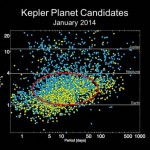W. M. Keck Observatory press release…
The Kepler team today reports on four years of observations from the W. M. Keck Observatory targeting Kepler’s exoplanet systems, announcing results this week at the American Astronomical Society meeting in Washington. These observations, from Keck Observatory on the summit of Mauna Kea, confirm that numerous Kepler discoveries are indeed planets and yield mass measurements of these enigmatic worlds that vary between Earth and Neptune in size.

Using one of the two world’s largest telescopes at Keck Observatory in Hawaii, scientists confirmed 41 of the exoplanets discovered by Kepler and determined the masses of 16. With the mass and diameter in-hand, scientists could immediately determine the density of the planets, characterizing them as rocky or gaseous, or mixtures of the two.
Continue reading “Kepler Team Validates 41 New Exoplanets with Keck”
